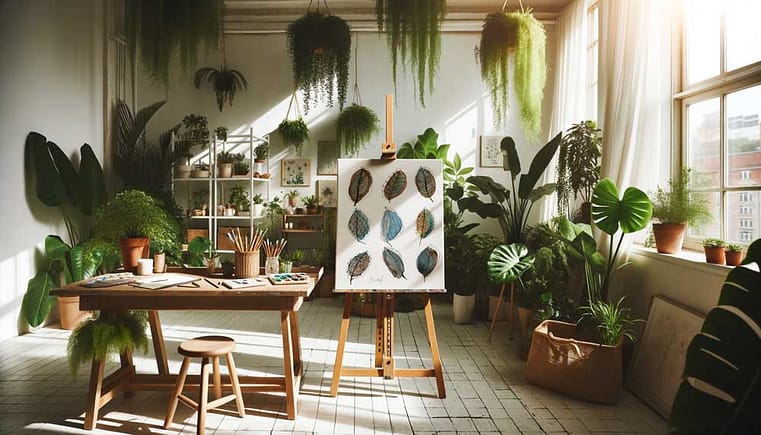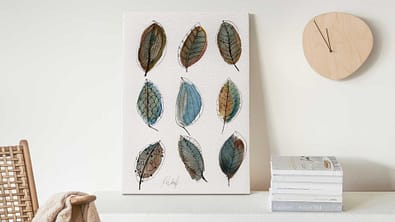Sketching is the foundation of every great artwork. It's the initial step in the artist's journey, allowing them to bring their imagination to life on paper. Whether you're a seasoned artist or a beginner, mastering the basics of sketching is essential. In this article, we'll delve into the tools you'll need, introduce some fundamental techniques, and offer tips to enhance your sketching process.

That was an artwork I had a lot of fun creating - in my class. If you like the watercolor artwork have a look at my store, you can find it as a downloadable poster there.
1. Essential Tools for Sketching
Every artist has their preferred set of tools, but if you're just starting out, it can be overwhelming to choose from the vast array of options available. Here are some essentials to get you started:
Pencils: Ranging from hard (H) to soft (B), each has its unique purpose. For fine lines, opt for H pencils, while B pencils are ideal for shading. In case you are painting with watercolor use a hard pencil, everything from H-H3 is fine. If you use a pencil that is too soft you have all the graphite on your paper and you can't get rid of it anymore when you have added watercolor. In the class "Create and sell Watercolor Wall Art as a downloadable File" I show you further why it's a good idea to use a hard pencil for watercolor drawings.
Eraser: A good quality eraser is crucial for correcting mistakes and creating highlights. Actually, for artists drawing with watercolor, there are two essential erasers: The eraser pencil and the artistic eraser you can knead.
Art Eraser Faber Castell*
Pencil Eraser*Sketchbook: Choose one with good-quality, thick paper that won't tear easily. Again, this is especially important if you want to add watercolor to your sketchbook but if it is just for basic sketches you do not need the highest quality paper.
My favorite Sketchbook*Sharpener: Ensure a fine point on your pencils for detailed work.
Fineliner: In the class mentioned above we use a Micron Fineliner* for the Line Art.
Investing in quality tools can make a significant difference in your sketching. Once you have your basics, you can expand your toolkit as you hone your skills.

Create and sell Watercolor Wall Art as a downloadable File
Create your own Wall Art and sell it online. I show you everything you need to know - from drawing with watercolor to digitizing and packaging!
2. Fundamental Techniques to Master
As with any skill, practice makes perfect. But knowing where to start can fast-track your progress. Here are some foundational techniques:
- Line Drawing: This is the backbone of sketching. Practice drawing straight, curved, and zigzag lines to build hand-eye coordination. We practice that in our beginner Watercolor Class which is also available in the Safari Lounge Designer Classes.
- Shading: Understand the play of light to create depth and volume in your sketches. Experiment with different gradients.
- Hatching and Cross-Hatching: These are shading techniques using parallel lines or crossed lines, respectively.
- Blending: Use your fingers or blending stumps to smoothly transition shades and create soft shadows.
Regularly practicing these techniques will provide you with a solid foundation. Dedicate time to mastering each one, as they are the building blocks of more advanced skills. With more advanced skills I mean switching to something like watercolor or acrylic painting.
3. Tips to Enhance Your Sketching
Even seasoned artists are always learning. Here are some tips to enhance your sketching experience:
- Practice Daily: Even a quick 5-minute sketch daily can drastically improve your skills over time. Like Jenna Rainey says "Draw every day, even if it sucks!" - I can just underline this!
- Use References: While creativity is paramount, using reference images can offer guidance, especially when you're trying to capture realism. If you need more inspiration join my free class "Finding Inspiration in Nature"
- Start with Simple Subjects: Before tackling complex subjects, start with basic shapes and objects to build confidence.
- Learn from Mistakes: Instead of erasing errors immediately, analyze them to understand what went wrong. It's a valuable learning opportunity.
- Join a Community: Engage with fellow artists. Sharing your work and getting feedback can offer new perspectives and growth opportunities. Beside that, it's so motivating to be in touch with like-minded people!
Improvement comes with patience, persistence, and a willingness to learn. Embrace every part of the journey, from the mistakes to the masterpieces.
Wrapping Up
Sketching is a beautiful blend of art and science. While it requires an understanding of tools and techniques, it also thrives on individual creativity and expression. By mastering the basics, you lay a strong foundation for a fulfilling artistic journey. Remember, every artist was once a beginner. So, pick up your tools, and let your creativity flow!
